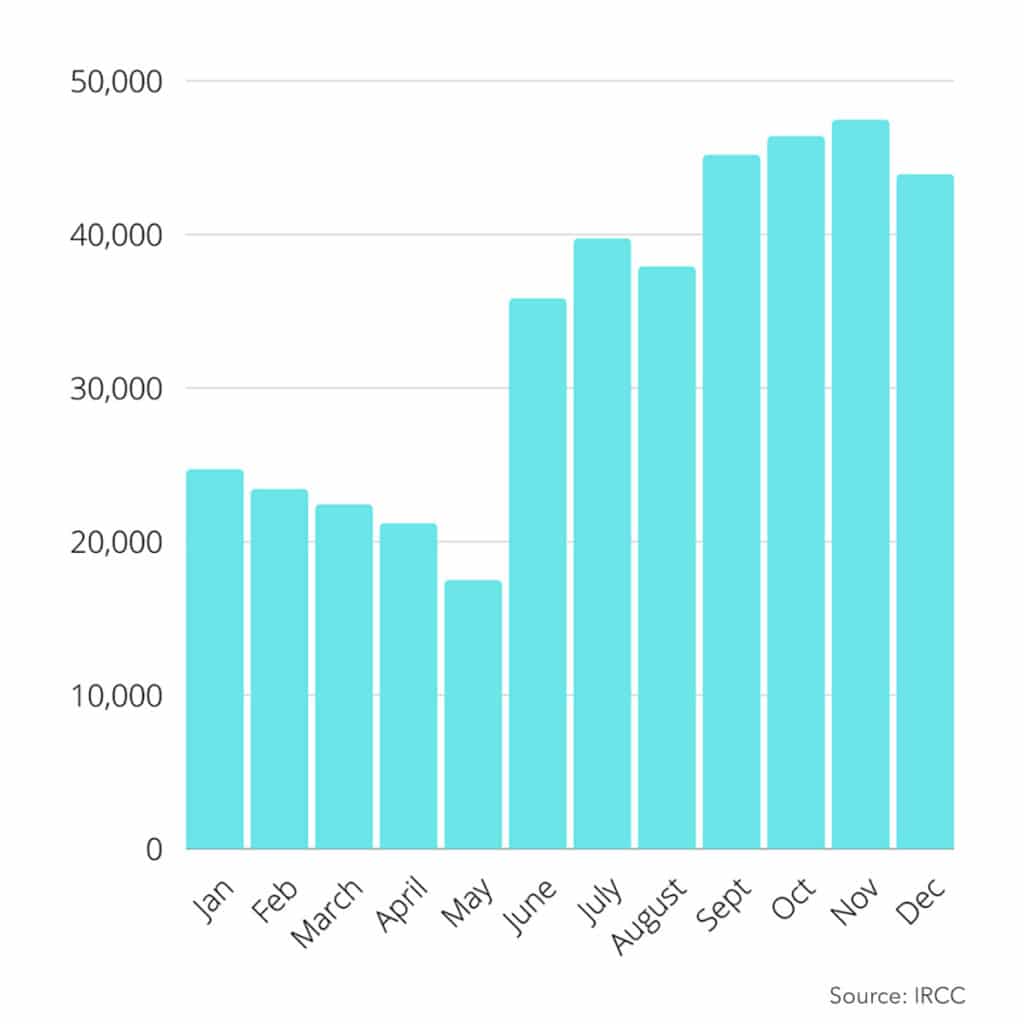How Canada landed 405,000 new immigrants in 2021
Canada exceeded its 2021 immigration target by landing 405,303 new permanent residents last year, according to new data obtained from IRCC by CIC News.
Canada has only surpassed 400,000 newcomers one other time in its history, in 1913. The following year, the First World War broke out, and immigration levels plummeted.
The Immigration Levels Plan 2021-2023 aimed to welcome 401,000 immigrants in 2021 to support Canada's post-pandemic economic recovery. In 2020, Canada only welcomed 184,000 new immigrants, and as a result the country's population growth fell to the lowest level since the First World War. Prior to the pandemic, Canada was targeting the arrival of 341,000 new immigrants per year.
Discover if You Are Eligible for Canadian Immigration
In 2021, Immigration, Refugees and Citizenship Canada (IRCC) focused on transitioning as many temporary residents who were already in Canada to permanent residents in order to meet its target. IRCC felt this was the most effective way to achieve its target amid COVID-19 travel restrictions and other pandemic related challenges. Among the measures it took to land more permanent residents from within Canada, IRCC held Express Entry draws that invited high totals of Canadian Experience Class (CEC) candidates from January until September. In May, IRCC launched six immigration streams ("TR to PR") in an effort to land some additional 90,000 international students and temporary foreign workers living in Canada.
Most of Canada's immigrants arrive under economic class programs. Prior to the pandemic, 30 per cent of new economic class landings were applicants from within Canada while 70 per cent were economic class arrivals from abroad. This was reversed in 2021, with 70 per cent landing from within Canada and 30 per cent coming from abroad.
IRCC's large CEC invitation rounds and the launch of the six TR to PR streams help to explain why its landings increased significantly in the second half of 2021. IRCC welcomed a large number of new in-Canada applications in the first half of last year and then ramped up processing by June and concluded the year landing upwards of 40,000 permanent residents per month.
Canada's new permanent resident landings by month in 2021

How did Canada's new immigrants land in 2021?
A total of 252,975 permanent residents landed under the economic class. This works out to 62 per cent of all immigrants landed in 2021, which is higher than the 58 per cent figure that was targeted under the 2021 levels plan. In fact, Canada welcomed over 20,000 more economic class immigrants in 2021 than it had targeted.
A total of 80,990 under family class landed in 2021, which was well short of the 103,500 family class immigrants Canada targeted under the 2021 levels plan. The family class accounted for 20 per cent of new landings last year, which was below the levels plan target of 26 per cent.
In all, 60,115 permanent residents landed as refugees and protected persons in Canada, slightly below the levels plan target of 65,000 people. This was 15 per cent of all new landings, a fraction below the 16 per cent targeted under the levels plan.
The remaining amount were classified by IRCC as falling under "All Other Immigration."
CEC leads the way accounting for almost one-third of new permanent residents
The CEC was the leading pathway for new permanent residents with 130,555 people landing under the program, or 32 per cent of all immigrants landed in 2021. In 2019, the CEC accounted for roughly 30,000 people or about 9 per cent of all new landings.
IRCC entered 2021 with the belief it would need to depend heavily on the CEC to achieve its 401,000 target. As an example of the great lengths it went to in order to land high levels of CEC candidates, the department invited all 27,332 CEC candidates in the Express Entry pool on February 13, 2021, by far the most exceptional draw in Express Entry's history. The draw was exceptional since it saw nearly five-times more invitations issued than the previous record, with the lowest Comprehensive Ranking System (CRS) score requirement since Express Entry was launched in 2015, and every single CEC candidate in the pool on that date receiving an invitation to apply for permanent residence.
IRCC only landed 8,320 people under the Federal Skilled Worker Program (FSWP) in 2021. Prior to the pandemic, the FSWP was the main program for new federal economic class landings. In 2019, Canada landed 58,760 immigrants under the FSWP.
The decline last year was a function of IRCC prioritizing CEC and other applications submitted from within Canada. Newer IRCC data suggests that FSWP application processing has increased since December, with IRCC now finalizing an average of 800 FSWP applications per week.
The Provincial Nominee Program (PNP) accounted for 53,960 landings last year. The PNP has been fully operational throughout the pandemic as IRCC and the provinces and territories have been holding regular invitation rounds, and in some cases, on a weekly basis.
Some 23,885 people landed under the temporary TR to PR program. This suggests IRCC is yet to land the bulk of the some 90,000 people that applied for the program in 2021.
Spouses and partners are the leading group of family class landings. They comprised 64,120 landings last year.
Discover if You Are Eligible for Canadian Immigration
Where did Canada's new immigrants land?
Ontario landed 49 per cent of all new immigrants last year, a higher share than the some 45 per cent it landed prior to the pandemic, in 2019. This can be explained in large part by IRCC's dependence on the CEC, given that most of these candidates reside in Ontario.
BC was another major beneficiary of IRCC's dependence on the CEC. It landed 17 per cent of all new immigrants, compared with 15 per cent in 2019.
Quebec came in third, at over 12 per cent of 2021 landings, followed by Alberta at almost 10 per cent. Quebec's share remained the same compared to 2019, whereas Alberta's share fell from the 13 per cent it landed in 2019. Alberta's lower share can be explained in large part to it not landing as many immigrants under the CEC as Ontario and BC. Manitoba and Saskatchewan saw their national shares also fall for the same reason.
The Atlantic region as a whole also saw their national share decline, since they depend on the PNP and the Atlantic Immigration Pilot for their arrivals. On the other hand, Nova Scotia set a provincial record by landing over 9,000 immigrants last year.
| Province/Territory | 2021 PRs | % of all PRs |
|---|---|---|
| Newfoundland and Labrador | 2,060 | 0.5% |
| Prince Edward Island | 2,630 | 0.6% |
| Nova Scotia | 9,020 | 2.2% |
| New Brunswick | 5,315 | 1.3% |
| Quebec | 50,170 | 12.4% |
| Ontario | 198,085 | 48.9% |
| Manitoba | 16,560 | 4.1% |
| Saskatchewan | 10,935 | 2.7% |
| Alberta | 39,950 | 9.9% |
| British Columbia | 69,270 | 17.1% |
| Yukon | 595 | 0.1% |
| Northwest Territories | 295 | 0.1% |
| Nunavut | 40 | 0.0% |
| Province not stated | 410 | 0.1% |
| Canada total | 405,330 | 100% |
Where did Canada's immigrants come from?
The top source countries of Canada's new immigrant landings are similar to those prior to the pandemic. India remains the leading source country, accounting for almost one-third of landings in 2021, compared with 25 per cent in 2019. This may potentially be explained by the high numbers of CEC landings. India is the main source of Canada's international students, and many of these students eventually gain permanent residence through the CEC.
IRCC's January to November data shows us the top 10 countries are as follows:
1) India (32%)
2) China (8%)
3) Philippines (4.3%)
4) Nigeria (3.8%)
5) France (3.2%)
6) United States (3%)
7) Brazil (2.9%)
8) Iran (2.8%)
9) South Korea (2.1%)
10) Pakistan (2%)
Immigration Levels Plan 2022-2024
Canada is targeting 411,000 landings in 2022, however this target could be updated when the federal government announces its new Immigration Levels Plan 2022-2024 by Monday February 14. The new plan will outline Canada's immigration targets over the next three years and the admission classes and programs they will be targeted under.
Discover if You Are Eligible for Canadian Immigration
© CIC News All Rights Reserved. Visit CanadaVisa.com to discover your Canadian immigration options.
- Do you need Canadian immigration assistance? Contact the Contact Cohen Immigration Law firm by completing our form
- Send us your feedback or your non-legal assistance questions by emailing us at media@canadavisa.com




